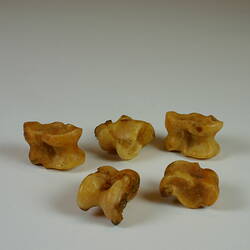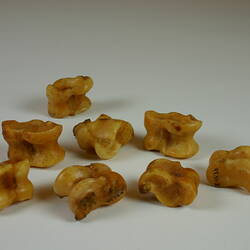Summary
Alternative Name(s): Knucklebone Jacks, Astragali, Astragalus, Talus
Knucklebones, or Jacks, is an ancient game, dating back to prehistoric times. The first jacks were natural materials - animal bones, stones, seeds and shells. Sheep's knucklebones were the most common type of jacks in Australia during the first half of this century, and children would colour them by boiling them in water with ink or dye. During the 1950s, mass-produced plastic knucklebones became available.
The Australian Children's Folklore Collection is unique in Australia, documenting contemporary children's folklore across Australia and in other countries reaching back to the 1870s. The Collection has a strong component of research material relating to Victoria.
Physical Description
Eight sheeps' knucklebones in natural state. All have yellowed with age, and they appear to have been scraped, although there are still dried bits of animal tissue attached to the bones.
More Information
-
Collection Names
-
Collecting Areas
-
Acquisition Information
Cultural Gifts Donation from Dr June Factor, 18 May 1999
-
Acknowledgement
Donated through the Australian Government's Cultural Gifts Program.
-
Classification
-
Category
-
Discipline
-
Type of item
-
Maximum dimensions
34 mm (Length), 30 mm (Width), 20 mm (Height)
Measurement From Conservation. Dimensions are approximate as knucklebones are not identical
-
Keywords
Children's Folklore, Children's Play, Farm Animals, Food Technology, Games, Livestock, Sheep, Making History - Australian Childrens Folklore



